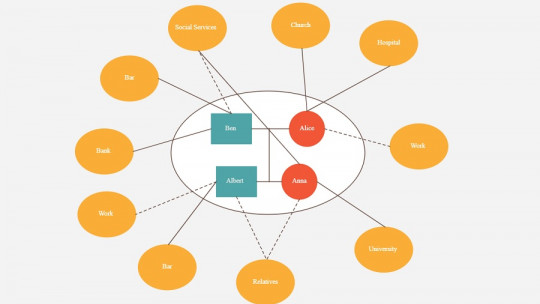
In social sciences and health sciences, it is often necessary to know what environment the family of the patient or patients lives in to know the origin of their problem.
Both the other members of the family and their interaction with the sociocultural environment in which they live can motivate different intra- and interrelational dynamics that lead to problems for its members.
A good way to know how a family relates to its environment are family ecomaps tools that we are going to discover below.
What is a family ecomap?
Among the multiple instruments to evaluate individuals, families and communities in the branches of health and social applied to the family environment is the ecomap. The family ecomap is a tool that allows us to appreciate the structure of a family and what connections there are between its members, also exposing what the extra-familial support is if it exists or is absent.
These tools are developed as a graphic representation to quickly identify the interrelationships of the family with the environment and its sociocultural context.
The ecomaps They are developed when a family is evaluated with the intention of knowing that there is a mutual influence between it as a social unit and the other systems with which it is related whether it be the extended family, health systems, educational centers, neighbors, the neighborhood, family friends…
Based on its definition we can understand that it has a certain resemblance to the familiogram or genogram, only that instead of focusing solely and exclusively on the family it also shows its external relationships, the main characteristic that differentiates it from genograms. However, like familiograms, family ecomaps are easy tools to create. Added to this, they have wide applicability and serve to plan, evaluate and intervene with families, seeing how they relate to other social groups.

Utilities and functions of the family ecomap
The family ecomap It presents certain facilities to the family therapist when treating a family unit and understanding what possible problems are occurring within it Among the uses of the main family ecomaps we have:
How to make an ecomap?
To create an ecomap We need at least a piece of paper and a pencil or pen, in addition to the information that the family provides us and that which we have observed both in its internal relational dynamics and with the systems external to it.
To create the ecomap we can follow the following 4 steps.
Step 1. Prepare the family diagram
We draw a circle in the center of the family. Within this circle we will create a small family diagram, that is, the members that make up the reference family unit. Although it is possible that grandparents, uncles, cousins or other second and third degree relatives acquire an important weight in the family unit studied, as a general rule we will focus on the most central family, that is, the couple and their respective children.
When making this small family tree it is necessary to know that men are represented with squares and women with circles. Marriages are represented by connecting the spouses with two vertical lines and one horizontal, from which the couple’s children are connected with their respective vertical lines.
Sons are represented with squares, and daughters with circles. In the case of a pregnant woman, the unborn child is represented with a triangle. If there have been abortions, they are represented either with a black dot (spontaneous) or with an X (induced). Twins are represented by two lines arising from the horizontal line at the same point.
If it is a marriage the line is continuous, if it is a premarital union the line is discontinuous and if it is a separated or divorced couple the horizontal line is “cut” with one or two diagonal lines. If a parent has custody of one of the children, the diagonals are drawn near the parent who does not have custody. In case custody is shared, the diagonals are drawn in half
Step 2. Add personal information
In case we have more information and enough space, we can write names, dates of birth, date of marriage, separation and/or divorce, deaths and any other family event important. Information relating to particular individuals may go within or alongside their symbols, while details of relationships between family members will be indicated on the line connecting them.
Step 3. Draw the external systems
Once the family diagram has been prepared, we proceed to consider what external systems influence the family or its members These systems can be of all types, and those that are significant for the family unit and that significantly influence it should always be considered.
Work, school, church, friends, neighborhood, health system are some examples of external systems that can be of great importance to the evaluated family. Each of these external systems will be represented with their corresponding circles around the main circle.
Step 4. Represent external influences
Once we have decided which are the most important external systems, it is time to relate them to the main family unit. For it Let’s connect them to the central circle, either as a whole or to specific individuals if they are especially significant to specific family members
These connections are represented in different ways depending on the type of influence they exert. For example, a solid line represents a strong connection; two or three solid lines represent an intense connection; a dashed or dotted line represents a rather modest connection and a wavy or broken line represents a conflicting connection.
To provide more information, Arrows can be used at the ends of each line, which will represent the directionality of the energy between the connections An arrow can be placed pointing towards a family member if it is influenced by the external system and, if the arrow is placed on the external system, this means that it is the family member that connects it who influences the same. The arrows on both sides represent a mutual influence between the connected elements.








